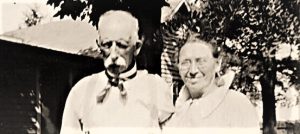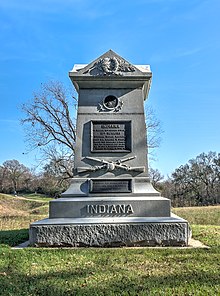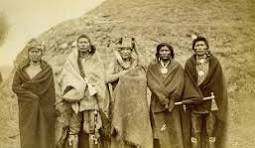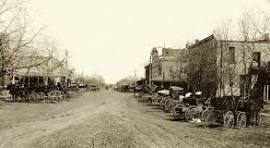My Paternal Grandparents both came from sizeable families. Grandfather Richard Deacon Blackwell had thirteen siblings born between 1835 and 1856 to James Hawkins Blackwell and Malinda Harrell in Ripley, lndiana. Malinda Harrell’s parents were John David Harrell and Cassia Deacon. (Richard Deacon’s middle name came from his Maternal Grandmother Cassia Deacon.) His siblings were George W., John H., Joseph Y., Martha, Elizabeth, Mildred, Mary J., William G, Jesse, Isaac, Melissa, Nancy, and Malinda.
Grandmother Mary Frances Doty was one of six children born between 1851 and 1861 to Abraham Doty and Mahala Bowles in Johnson County, Indiana. Her siblings included Jerome Thomas, Sarah, Minerva, Lucy, 1859, and Alonzo.
After my Paternal Grandparents were married in Johnson County, Indiana on 5 October 1869, they

moved to Boone County near Lebanon. I don’t know what my Grandfather Blackwell did for a living between his marriage in 1869 and 1876 when he moved the family to Kansas. Whatever it was, like many others of his peers, he must have felt that grass was greener “out there in Kansas.” ln 1876, they moved by covered wagon from Indiana to Kansas and lived in the Douglass area for the rest of their lives. They had five children: Chalmers Abraham, born in Indiana; and the other four, born in Kansas, Maud Ethel, Otie Blanche, Daisy, and my father Virgil Richard. All Blackwell children, including my Father, spent their lives in Kansas.

Grandfather Richard Deacon Blackwell joined the Union Army when he was seventeen. In 1864-1865 he was a member of Company H of the Eleventh Indiana Cavalry. That unit, among others, was command by the Indiana native, General Lew Wallace (1827-1905), whose fame as a soldier was surpassed by that as author of the popular book Ben Hur. From official U S Army records concerning Co H Eleventh Cav their general movements are known but their actual detailed participation in skirmishes or battles is not completely known. The following details concerning the Eleventh Indiana Cavalry were reported in a web site of Kristopher Ligget.
“The Eleventh Indiana Cavalry was organized during the period of 10 November 1863 to 2 April 1864 at Indianapolis, Lafayette and Kokomo. Its first movement was to Nashville, Tennessee from 7 May to 1 June 1864. It next was headquartered in Larkinsville, Alabama until 16 October and performed guard duty along the Memphis and Charleston Railroad in Alabama. From 30 September to 1 October it participated in defense of Huntsville, Alabama against General Buford’s attack. It moved back to Nashville, Tennessee 16 October. A detachment participated in siege of Decatur, Alabama 26-29 October. In November and December 1864 the Eleventh took part in the Nashville Campaign: Shoal Creek 16-20 November; Maysville and New Market 17 November; Columbia 24-27 November; Duck River 28 November; Battle of Franklin 30 November; Paint Rock Bridge, Alabama 7 December; Battle of Nashville 15-16 December. Pursuit of General Hood to Tennessee River 17-28 December: West Harpeth River !7 December, Richland Creek 24 December, Pulaski 25-26 December, Hillsboro, Alabama 29 December (Detachment), Leighton, Alabama 30 December (Detachment). From 7 January to 7 February,1865 , the Eleventh had duty at Gravelly Springs, Alabama and from 7 February to 12 May, at Eastport, Mississippi. It moved to St.Louis, Missouri 12-17 May; next to Rolla, Missouri on 20-26 June and to Fort Riley, Kansas 29 June-8 July. Next the Eleventh moved to Council Grove, Kansas–headquartered at Cottonwood Crossing–until 1 September with patrol duty along Santa Fe trail. 1 to 11 September it marched to Fort Leavenworth, Kansas and was mustered out on 19 September 1965.”
During Summer 1965 Grandpa Blackwell’s group had camped for an interval near confluence of Little Arkansas River and Arkansas Rivers. That settlement grew to be the city of Wichita. That time spent in Kansas must have influenced my Grandfather when he later decided to take his family West to homestead. Beginning in about 1874, vast areas of government land in the West were opened up for settlement where settler families could get one hundred Sixty acres of land for $l.50 per acre.
The original homestead where my Grandparents and their first two children, Chalmers Abraham and Maud Ethel, settled was about twenty-five miles East of Wichita and about ten miles Northwest of Douglass in Butler County near Augusta, Kansas. Their first dwelling on that homestead was a crude one, common at that time, which was a combination of a partial dugout topped with sod walls. The sod walls were referred to by the settlers as “Nebraska marble.” By the time they had arrived in Kansas in that Centennial Year my Grandparents were in little danger from Indians who remained active intermittently in nearby states. Custer’s Battle of Little Bighorn, in June 1876, occurred at about the time my Grandparents were peacefully getting settled on their Kansas homestead.
My Grandmother, like most pioneer wives, did work in the fields along with her man as well as her housework. She was no stranger to physical work; as a young girl she had helped her Father, Abraham Doty, in his blacksmith shop. She was accustomed to farm animals and as a young girl had enjoyed horseback riding and had her own horse. I don’t know what crops they planted on that first Kansas homestead but from my Grandmother’s remarks they had a hard time keeping food on the table.

One experience that Grandmother used to mention about those early times in their first Kansas homestead had to do with their struggle to find enough to eat. At one point they were very low on food and had gone without much meat for some time. In desperation my Grandfather traded one of his rifles for a hog which they butchered. They were looking forward to some welcome pork but just when they were about to have their first bountiful meal three very hungry Indian men came to their door and asked for something to eat. Apparently Richard Deacon never tuned away a hungry person so he invited them in and they consumed a lot of the food to the dismay of Mary Frances. As she recalled in later years she cowered in a corner-frightened of those strange intruders– holding Baby Maud, watching precious food vanish and wondering where the future might lead.
Of course, later in life, she too never turned away a hungry stranger. During the Depression years of the Thirties, when many men were reduced to homeless wandering across the US, some passed along the nearby highway in our little town and some stopped to ask for a handout. She always found something for them. I still have a vivid memory of one man sitting at our dining table and devouring a plate of boiled potatoes and bread which were all that my Grandmother had to offer at the time.
After a few years at that first farm the family moved to a farm East of Douglass and then to Douglass

where they remained the rest of their lives. My Grandfather became US Deputy Marshall and later Town Marshall in Douglass. He maintained that job until he died at nearly seventy-four on Christmas Day 1919. Douglass was not a rough tough frontier Kansas town like storied Abilene and Dodge City. Grandpa’s job as Marshall was peaceful in contrast to legendary hazardous times of the Matt Dillons and Wyatt Earps. There were no family stories of gunplay involving Grandpa Blackwell. Although Jesse and Frank James and the Younger brothers, robbed trains and banks in Kansas among other places, the Douglass Bank was never robbed. The last of the robberies in Southeastern Kansas by the Youngers ended in October 1895 when they were killed in a shootout in Coffeeville, Kansas while trying to rob two banks at the same time. When I was small my Grandmother still had Grandpa’s service revolver; there was no indication from family lore that it had ever been fired in anger.
In 1893 my Grandfather, accompanied by his son, Chalmers, made the Cherokee Strip run in an effort to homestead land in that Oklahoma territory. Since Grandpa didn’t get any land he must have been too slow, for among those numerous runners beaten out by the “Sooners” who illegally sneaked into the area ahead of the starting gun and staked claims to be recorded early after the gun. During that run my Grandfather met another Blackwell, with no apparent relationship, who was namesake of the later town of Blackwell, Oklahoma.
My Grandfather was active in the GAR, the Civil War Union Army veterans organization: the Grand Army of the Republic formed in 1866. Richard Deacon attended the GAR Golden Jubilee Encampment Week in Kansas City, Kansas in Fall 1916. An indication of his probable attendance at an 1895 Jubilee GAR encampment is a pretty little souvenir glass from that gathering engraved “To my dear wife Mary.” My Grandmother was active in women’s auxiliary of GAR: the Relief Corps. In addition to decorating family plots on “Decoration Day” every 30 May, she put American flags on the Veterans Memorial monument in Douglass Cemetery.
